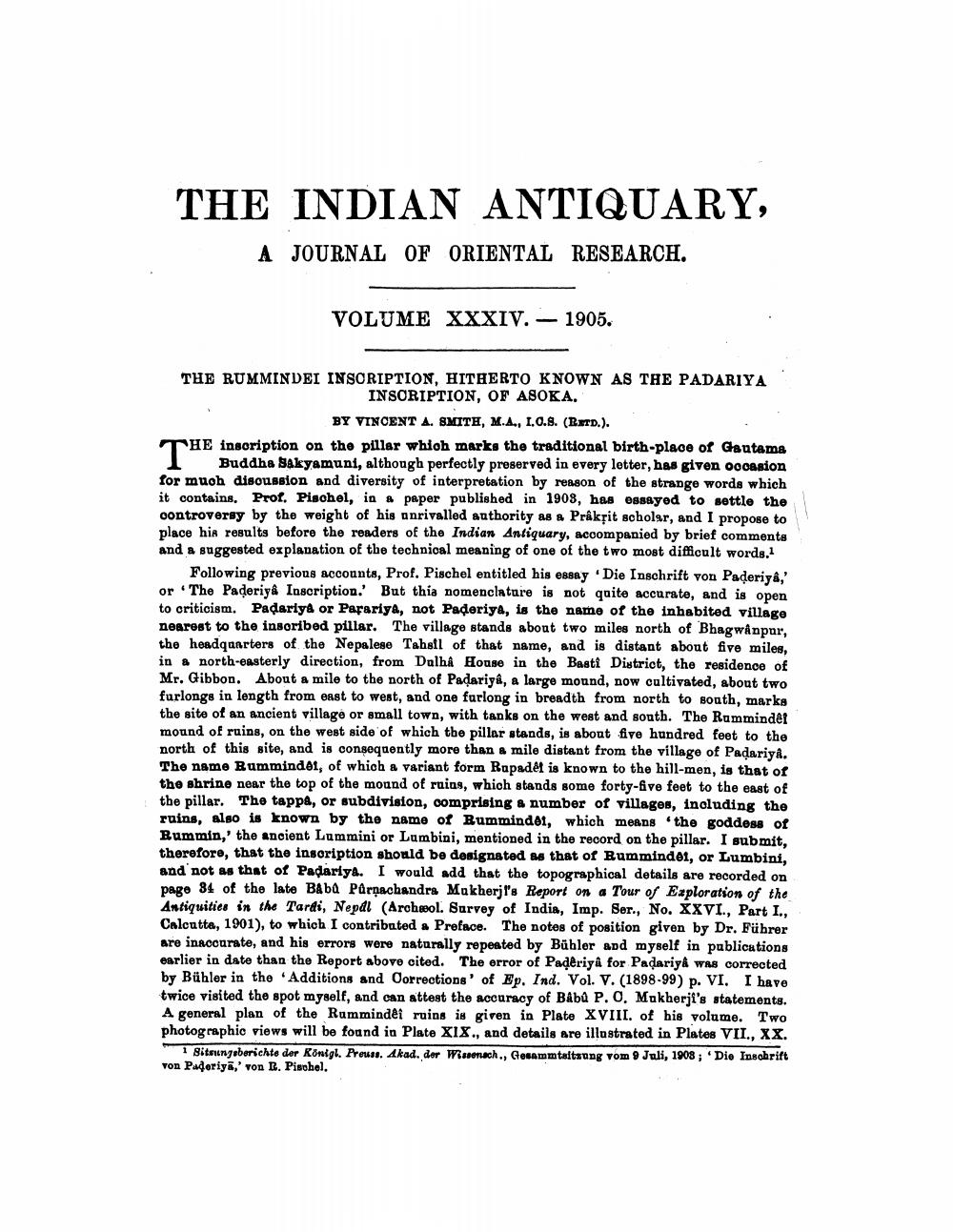Book Title: Indian Antiquary Vol 34 Author(s): Richard Carnac Temple Publisher: Swati Publications View full book textPage 7
________________ THE INDIAN ANTIQUARY, A JOURNAL OF ORIENTAL RESEARCH. VOLUME XXXIV. - 1905. THE RUMMINDEI INSCRIPTION, HITHERTO KNOWN AS THE PADARIYA INSCRIPTION, OF ASOKA. BY VINCENT A. SMITH, M.A., 1.0.9. (Red.). THE inscription on the pillar which marks the traditional birth-place of Gautama Buddha Sakyamuni, although perfectly preserved in every letter, has given occasion for much disoussion and diversity of interpretation by reason of the strange words which it contains, Prof. Pisohel, in # paper published in 1908, has essayed to settle the controversy by the weight of his anrivalled authority as a Prâkțit scholar, and I propose to place his results before the readers of the Indian Antiquary, accompanied by brief comments and a suggested explanation of the technical meaning of one of the two most difficult words. Following previous accounts, Prof. Pischel entitled his essay Die Inschrift von Paderiyê,' or The Paderiyê Inscription. But this nomenclature is not quite accurate, and is open to criticism. Padariya or Pafariya, not Paderiya, is the name of the inhabited village nearest to the insoribed pillar. The village stands about two miles north of Bhagwânpar, the headqaarters of the Nepalese Tahsil of that name, and is distant about five miles, in a north-easterly direction, from Dalha House in the Basti District, the residence of Mr. Gibbon. About a mile to the north of Padariyê, a large mound, now cultivated, about two furlongs in length from east to west, and one furlong in breadth from north to south, marks the site of an ancient village or small town, with tanks on the west and south. The Rumminder mound of ruins, on the west side of which the pillar stands, is about five hundred feet to the north of this site, and is consequently more than a mile distant from the village of Padariya. The name Rummindel, of which a variant form Rapadet is known to the hill-men, is that of the shrine near the top of the mound of ruins, which stands some forty-five feet to the east of the pillar. The tappe, or subdivision, comprising & number of villages, including the ruins, also is known by the name of Bummindoi, which means the goddess of Bummin,' the ancient Lummini or Lumbini, mentioned in the record on the pillar. I submit, therefore, that the insoription should be designated as that of Rummindoi, or Lumbini, and not as that of Padariya. I would add that the topographical details are recorded on page 84 of the late Baba Párnachandra Makherjl's Report on a Tour of Exploration of the Antiquities in the Tardi, Nepal (Archeol. Survey of India, Imp. Ser. No. XXVI., Part I., Calcutta, 1901), to which I contributed a Preface. The notes of position given by Dr. Führer are inaccurate, and his errors were naturally repeated by Bühler and myself in publications earlier in date than the Report above cited. The error of Paderiyâ for Padariyê was corrected by Bühler in the 'Additions and Corrections' of Ep. Ind. Vol. V. (1898-99) p. VI. I have twice visited the spot myself, and can attest the accuracy of BAbû P. O. Mukherji's statements. A general plan of the Rummindei ruins is given in Plate XVIII. of his volume. Two photographio views will be found in Plate XIX., and details are illustrated in Plates VII., XX. 1 Sitruungsberichte der Königl. Preuss. Akad. der Wissensch., Gesammtaltzung vom 9 Juli, 1908; Die Inschrift von Pateriya,' von R. Pischel.Page Navigation
1 ... 5 6 7 8 9 10 11 12 13 14 15 16 17 18 19 20 21 22 23 24 25 26 27 28 29 30 31 32 33 34 35 36 37 38 39 40 41 42 43 44 45 46 47 48 49 50 51 52 53 54 55 56 57 58 59 60 61 62 63 64 65 66 67 68 69 70 71 72 ... 548
